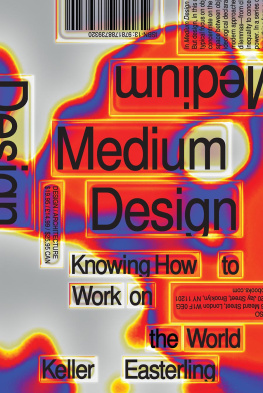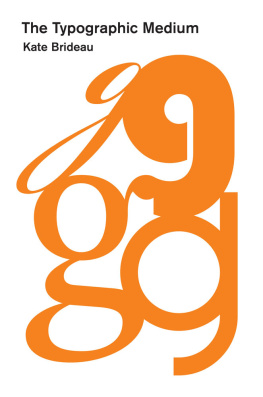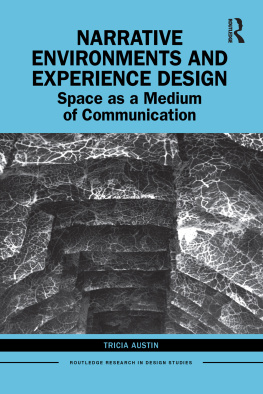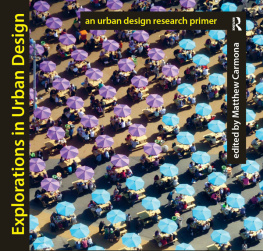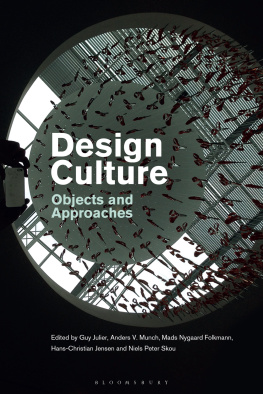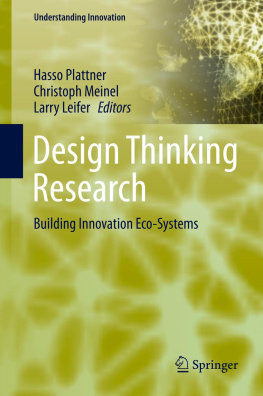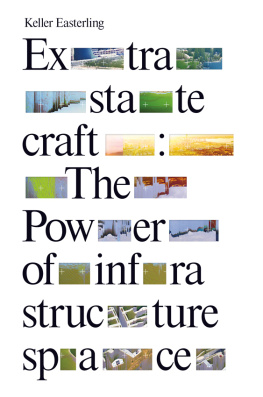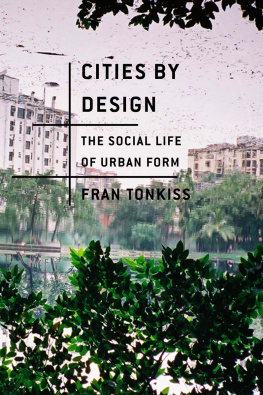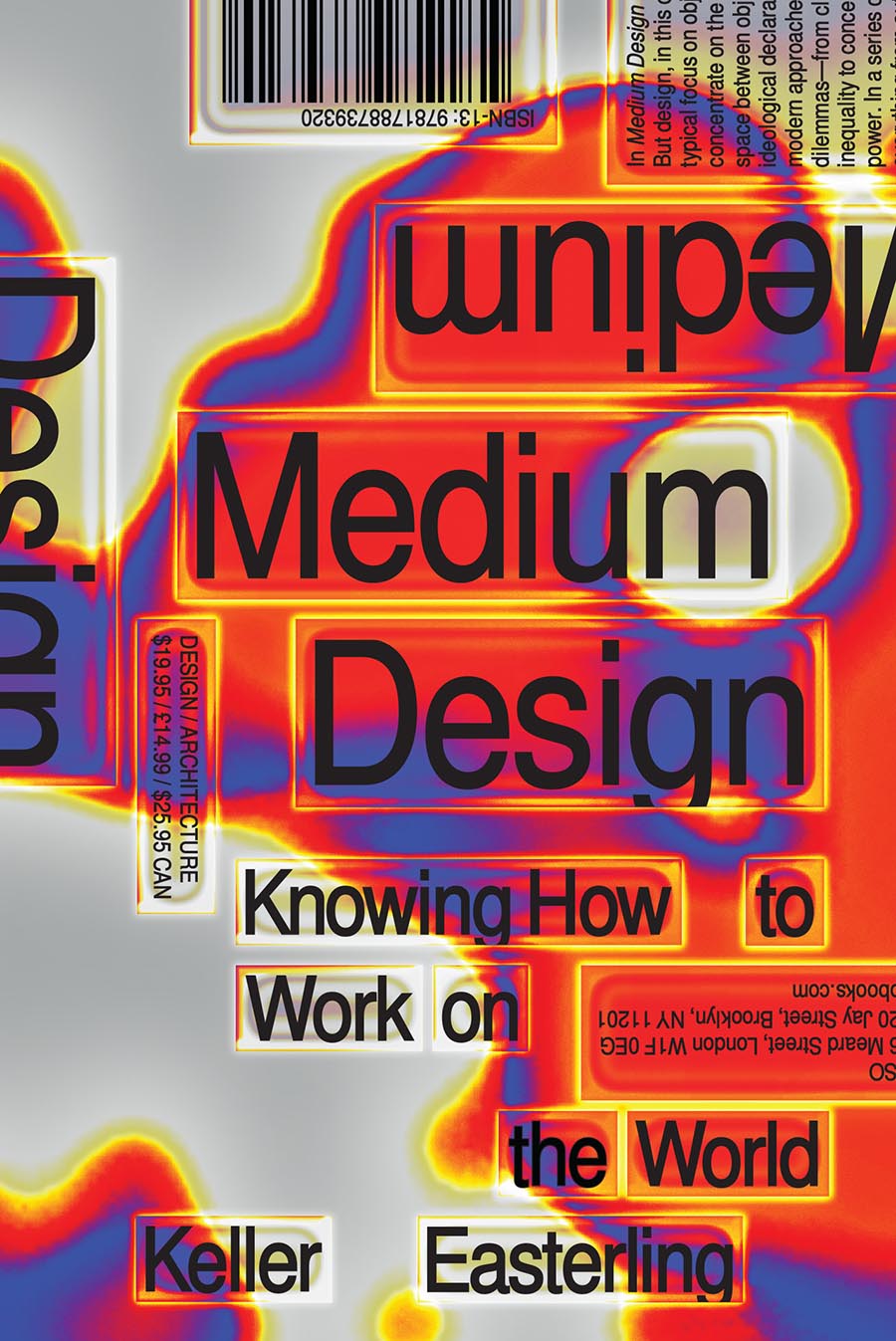
Medium Design
This eBook is licensed to Simon Karoly, simonkaroly123@gmail.com on 02/09/2021
Medium Design
Knowing How to
Work on the World
Keller Easterling

This eBook is licensed to Simon Karoly, simonkaroly123@gmail.com on 02/09/2021
First published by Verso 2021
Keller Easterling 2021
All rights reserved
The moral rights of the author have been asserted
1 3 5 7 9 10 8 6 4 2
Verso
UK: 6 Meard Street, London W1F 0EG
US: 20 Jay Street, Suite 1010, Brooklyn, NY 11201
versobooks.com
Verso is the imprint of New Left Books
ISBN-13: 978-1-78873-932-0
ISBN-13: 978-1-78873-935-1 (UK EBK)
ISBN-13: 978-1-78873-934-4 (US EBK)
British Library Cataloguing in Publication Data
A catalogue record for this book is available from the British Library
Library of Congress Cataloging-in-Publication Data
A catalog record for this book is available from the Library of Congress
Typeset in Sabon by MJ & N Gavan, Truro, Cornwall
Printed and bound by CPI Group (UK) Ltd, Croydon CR0 4YY
This eBook is licensed to Simon Karoly, simonkaroly123@gmail.com on 02/09/2021
Contents
This eBook is licensed to Simon Karoly, simonkaroly123@gmail.com on 02/09/2021
The objects in a simple roomtable, chair, lamp, pen, teapot, teacup, apple, and windoware performing. Although static, they are projecting latent potentials, activities, and relationships. The chair is sized to accommodate a seated human body, and the table is sized to allow the human and the chair to slide underneath it. The teapot and teacup have handles that fingers can wrap around, and the apple is a fruit that a hand can grasp. Some of the interactions are timed. The tea will go cold. The sun will go down, and the lamp will go on. Each of the objects in the assembly offers some properties or capacities that are in interplay.
Culture is very good at pointing to things and calling their name, but not so good at describing the chemistry between things or the repertoires they enact. It is easy to see how a sailor or a meteorologist works within swirling kinetic atmospheres of air or water, but not so easy to see the interactivity between static objects that make up any ordinary surrounding environment. These things with names, shapes, and outlines are usually valued in markets and possessed as property, and they are generally regarded to be inert or inactive rather than dancing with interdependent potentials.
The periodic table charts elements according to their reactivity, volatility, or tendency to generate molecular bonds. But if thousands of years of history are any evidence, culture perceives substances like silver and gold not as entities in an array of potentials, but as objectslumps of metal to be hoarded and beaten into adornments or currencies in a primitive urge for power. Maybe when encountering most substances, technologies, and practices, the modern Enlightenment mind prefers to pluck them from their active matrix and fix their name and position rather than indulging an imagination about their interdependence.
And yet, while perhaps not foregrounded in many cultural scripts, it is quite common to get through the day by managing potentials. The most resourceful, practical cooks know how to triangulate between the contents of their refrigerator, their pantry, and the food preferences of those for whom they wish to cook. Rather than cooking from a recipe, the mind clicks through hundreds of possible combinations between a half cup of milk that will only last one more day, two eggs, frozen peas, baking soda, cilantro leaves, hot sauce, a half stick of butter, a cheese rind, tomato paste, a tin of sardines, and two bananas. Quantities, expiration dates, cooking times, the mood and hunger of the intended recipient, and thousands of other factors are thrown into the calculations until the cook arrives at a meal that is often mistakenly treated as a relatively simple outcome.
A parent with squabbling children does not attempt to litigate or parse the content of the argument, but rather manages potentials in the environment. They might lower the temperature of the room, move a chair into the light, increase the blood sugar of one child, or introduce a pet into the arms of another so that the chemistry of the room no longer induces or supports violence.
A dog hears a human speak the words good girl, but it does not take meaning from the lexical expression alone. The dog also gathers meaning from many other cues and relative positions between things in context: whether the human is holding a leash and their position relative to the door or the dog bowl. Together with the sound of words, the dog assesses all of these potentials.
Similarly, an urbanist, with something like a canine mind, observes the city as a collection of reactive or interdependent components. It is easy to see the choreography of moving parts like cars and pedestrians as they synchronize and intersect. But urbanists look at urban spaces like streets and assess potentials even in the relationships between their static solids. An ethnographer may interview the inhabitants. An economist may gather data about livelihood. But an urbanist observes an interplay of physical contours that are also expressing limits, capacities, and values.
A street with many small lots, many doors and windows, and a heterogeneous mixture of uses possesses a chemistry different from a street with only a few large lots, one entry, and one function. Urbanists may observe the relationship between a traffic light, a business that offers coffee in the morning, and a set of buildings that have inhabitants who care for the street. And they can see the matrix of exchanges between a subway stop and a giant building with a huge volume of inhabitants. Not morphology alone, but the interaction between components, determines the richness of this loose and changeable assembly of parts. There may be no set structural rules and few determinantsonly some dynamic markers of changing relationships.
The chemist, cook, parent, dog, or urbanist is considering the activities and dispositions of objects, where disposition describes the agency or potential immanent in an arrangementa property or propensity within a context or relationship. You might assess the disposition of someones personality over time or the disposition of a house in relation to the weather or landscape, just as you might describe the disposition of an organization. The disposition of any organization makes some things possible and some things impossible. A ball on an inclined plane possesses disposition. Its position and geometry in relation to gravity and the pitch of the plane sets up a potential.
Even though it may seem to be all too obvious, thinking in this way is at once common, often unexpressed, and profoundly underexploited. It requires an inversion of the dominant cultural constructs that are dependent on declarationlabeling or defining the recipe, style, property, or ideology. Favoring nominative or quantitative expressions over expressions of disposition, culture privileges what philosopher Gilbert Ryle called the difference between knowing that and knowing howsomething like the difference between knowing the right answer and exercising experienced reactions unfolding over time.
This book rehearses the faculties of knowing how. It asks readers to look with half-closed eyes at the world, focusing not only on objects with names, shapes, and outlines, but also on the matrix or medium of activities and latent potentials that those objects generate. It looks beyond object to matrix. It looks beyond nominative expressions to infinitive expressions of activity and interplay. And it looks beyond declared ideologies to undeclared dispositionsbeyond the authority of economic or political labels that often obscure or misrepresent latent potentials in organizations of all kinds.
Next page
